PUBH5754 Assignment 1: Alcohol Consumption, NCDs and Injury Risks
VerifiedAdded on 2023/01/18
|16
|5634
|20
Literature Review
AI Summary
This literature review examines the significant health risks associated with unhealthy alcohol consumption, focusing on its relationship with non-communicable diseases (NCDs) and increased risks of injury. The review delves into the prevalence of alcohol-related health issues globally and specifically in Australia, highlighting the impact on morbidity and mortality. It explores the health belief model as a framework for understanding individual behaviors related to alcohol consumption and identifies various short-term and long-term health consequences. The review also analyzes the causal relationships between alcohol and specific NCDs, such as cardiovascular diseases, cancer, and liver diseases, while examining the impact of socioeconomic factors and gender differences. Finally, it discusses effective interventions and strategies for managing NCDs and reducing alcohol-related injuries, emphasizing the need for comprehensive public health approaches and the importance of monitoring risk factors and implementing targeted interventions.
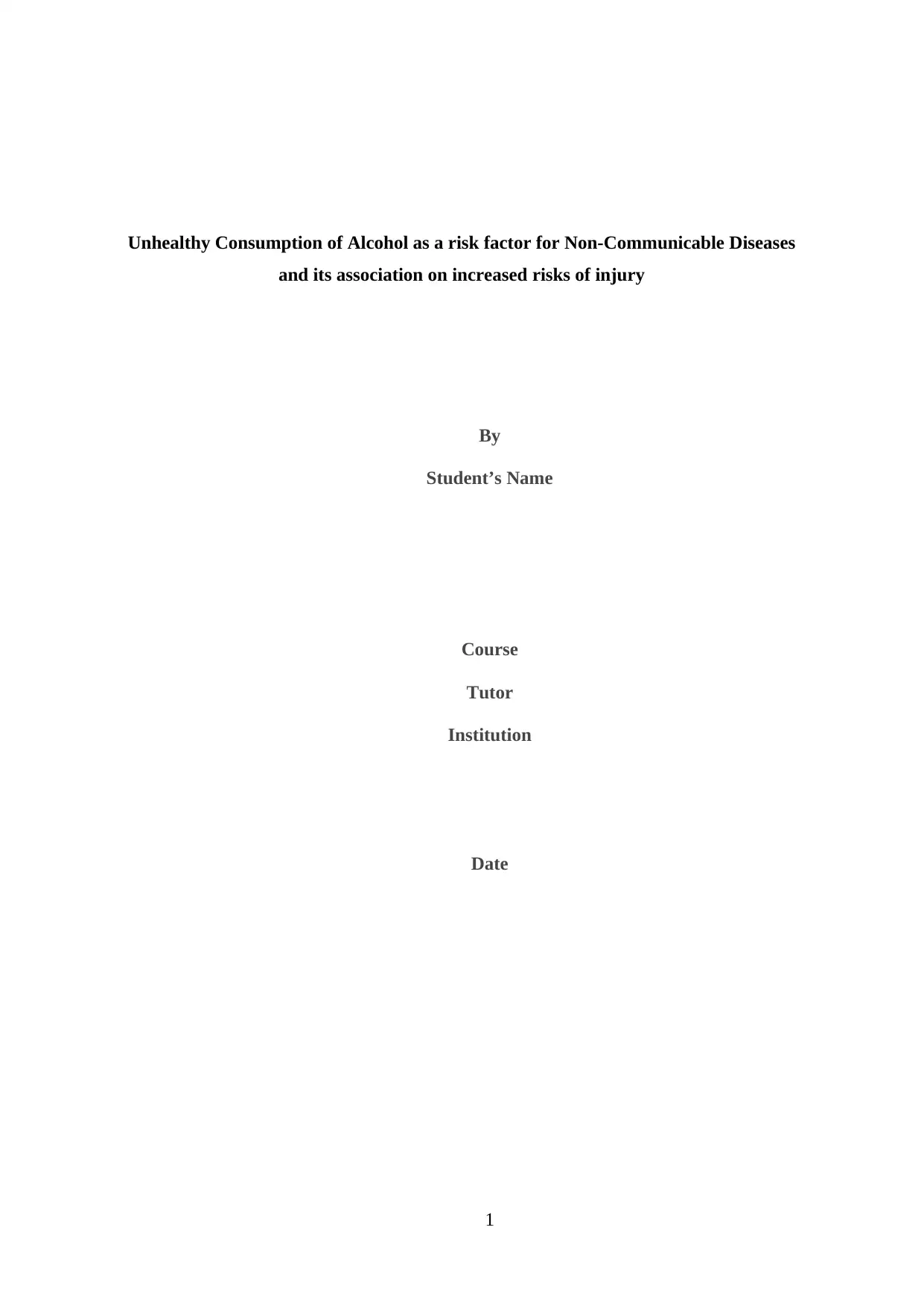
Unhealthy Consumption of Alcohol as a risk factor for Non-Communicable Diseases
and its association on increased risks of injury
By
Student’s Name
Course
Tutor
Institution
Date
1
and its association on increased risks of injury
By
Student’s Name
Course
Tutor
Institution
Date
1
Paraphrase This Document
Need a fresh take? Get an instant paraphrase of this document with our AI Paraphraser
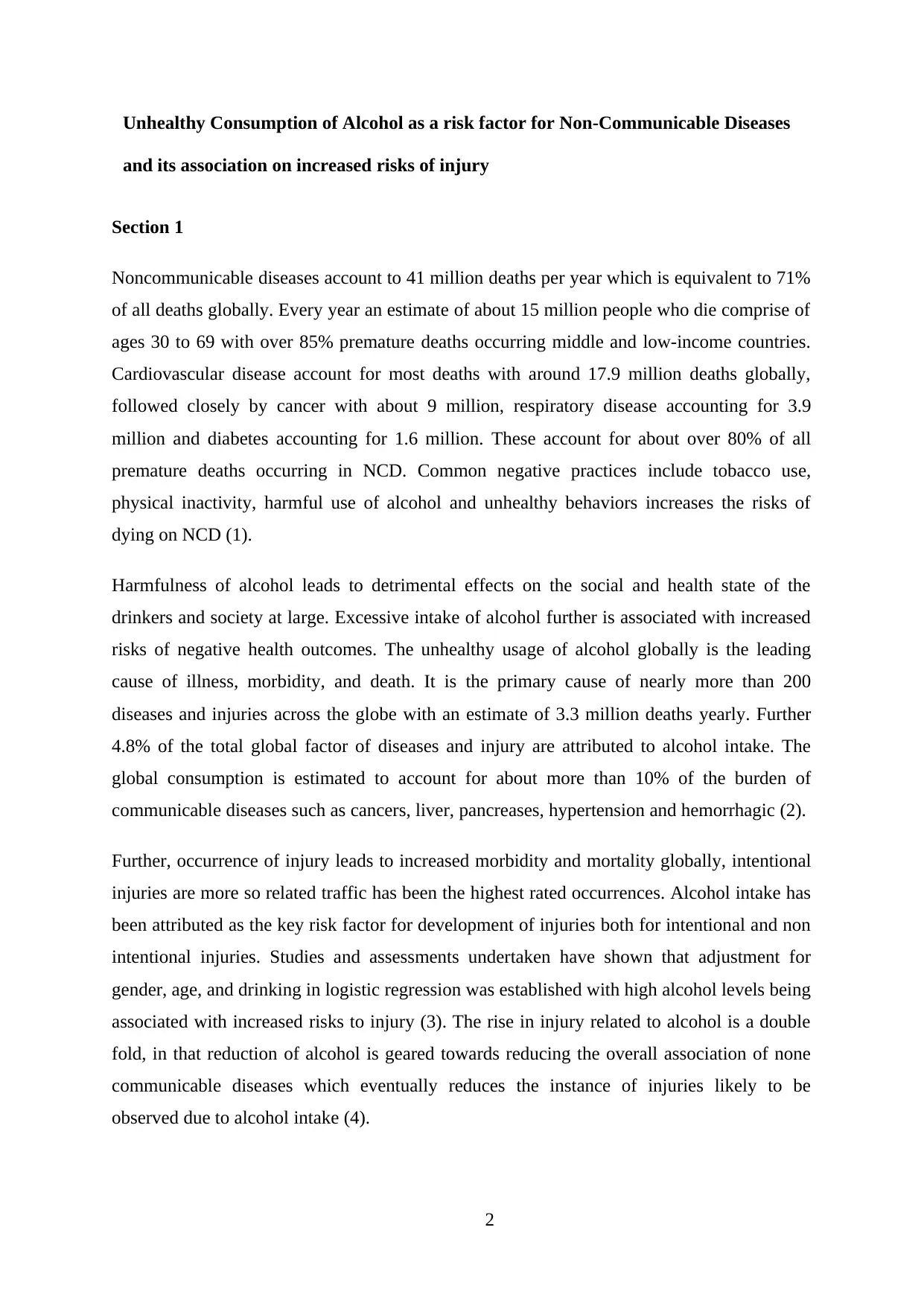
Unhealthy Consumption of Alcohol as a risk factor for Non-Communicable Diseases
and its association on increased risks of injury
Section 1
Noncommunicable diseases account to 41 million deaths per year which is equivalent to 71%
of all deaths globally. Every year an estimate of about 15 million people who die comprise of
ages 30 to 69 with over 85% premature deaths occurring middle and low-income countries.
Cardiovascular disease account for most deaths with around 17.9 million deaths globally,
followed closely by cancer with about 9 million, respiratory disease accounting for 3.9
million and diabetes accounting for 1.6 million. These account for about over 80% of all
premature deaths occurring in NCD. Common negative practices include tobacco use,
physical inactivity, harmful use of alcohol and unhealthy behaviors increases the risks of
dying on NCD (1).
Harmfulness of alcohol leads to detrimental effects on the social and health state of the
drinkers and society at large. Excessive intake of alcohol further is associated with increased
risks of negative health outcomes. The unhealthy usage of alcohol globally is the leading
cause of illness, morbidity, and death. It is the primary cause of nearly more than 200
diseases and injuries across the globe with an estimate of 3.3 million deaths yearly. Further
4.8% of the total global factor of diseases and injury are attributed to alcohol intake. The
global consumption is estimated to account for about more than 10% of the burden of
communicable diseases such as cancers, liver, pancreases, hypertension and hemorrhagic (2).
Further, occurrence of injury leads to increased morbidity and mortality globally, intentional
injuries are more so related traffic has been the highest rated occurrences. Alcohol intake has
been attributed as the key risk factor for development of injuries both for intentional and non
intentional injuries. Studies and assessments undertaken have shown that adjustment for
gender, age, and drinking in logistic regression was established with high alcohol levels being
associated with increased risks to injury (3). The rise in injury related to alcohol is a double
fold, in that reduction of alcohol is geared towards reducing the overall association of none
communicable diseases which eventually reduces the instance of injuries likely to be
observed due to alcohol intake (4).
2
and its association on increased risks of injury
Section 1
Noncommunicable diseases account to 41 million deaths per year which is equivalent to 71%
of all deaths globally. Every year an estimate of about 15 million people who die comprise of
ages 30 to 69 with over 85% premature deaths occurring middle and low-income countries.
Cardiovascular disease account for most deaths with around 17.9 million deaths globally,
followed closely by cancer with about 9 million, respiratory disease accounting for 3.9
million and diabetes accounting for 1.6 million. These account for about over 80% of all
premature deaths occurring in NCD. Common negative practices include tobacco use,
physical inactivity, harmful use of alcohol and unhealthy behaviors increases the risks of
dying on NCD (1).
Harmfulness of alcohol leads to detrimental effects on the social and health state of the
drinkers and society at large. Excessive intake of alcohol further is associated with increased
risks of negative health outcomes. The unhealthy usage of alcohol globally is the leading
cause of illness, morbidity, and death. It is the primary cause of nearly more than 200
diseases and injuries across the globe with an estimate of 3.3 million deaths yearly. Further
4.8% of the total global factor of diseases and injury are attributed to alcohol intake. The
global consumption is estimated to account for about more than 10% of the burden of
communicable diseases such as cancers, liver, pancreases, hypertension and hemorrhagic (2).
Further, occurrence of injury leads to increased morbidity and mortality globally, intentional
injuries are more so related traffic has been the highest rated occurrences. Alcohol intake has
been attributed as the key risk factor for development of injuries both for intentional and non
intentional injuries. Studies and assessments undertaken have shown that adjustment for
gender, age, and drinking in logistic regression was established with high alcohol levels being
associated with increased risks to injury (3). The rise in injury related to alcohol is a double
fold, in that reduction of alcohol is geared towards reducing the overall association of none
communicable diseases which eventually reduces the instance of injuries likely to be
observed due to alcohol intake (4).
2
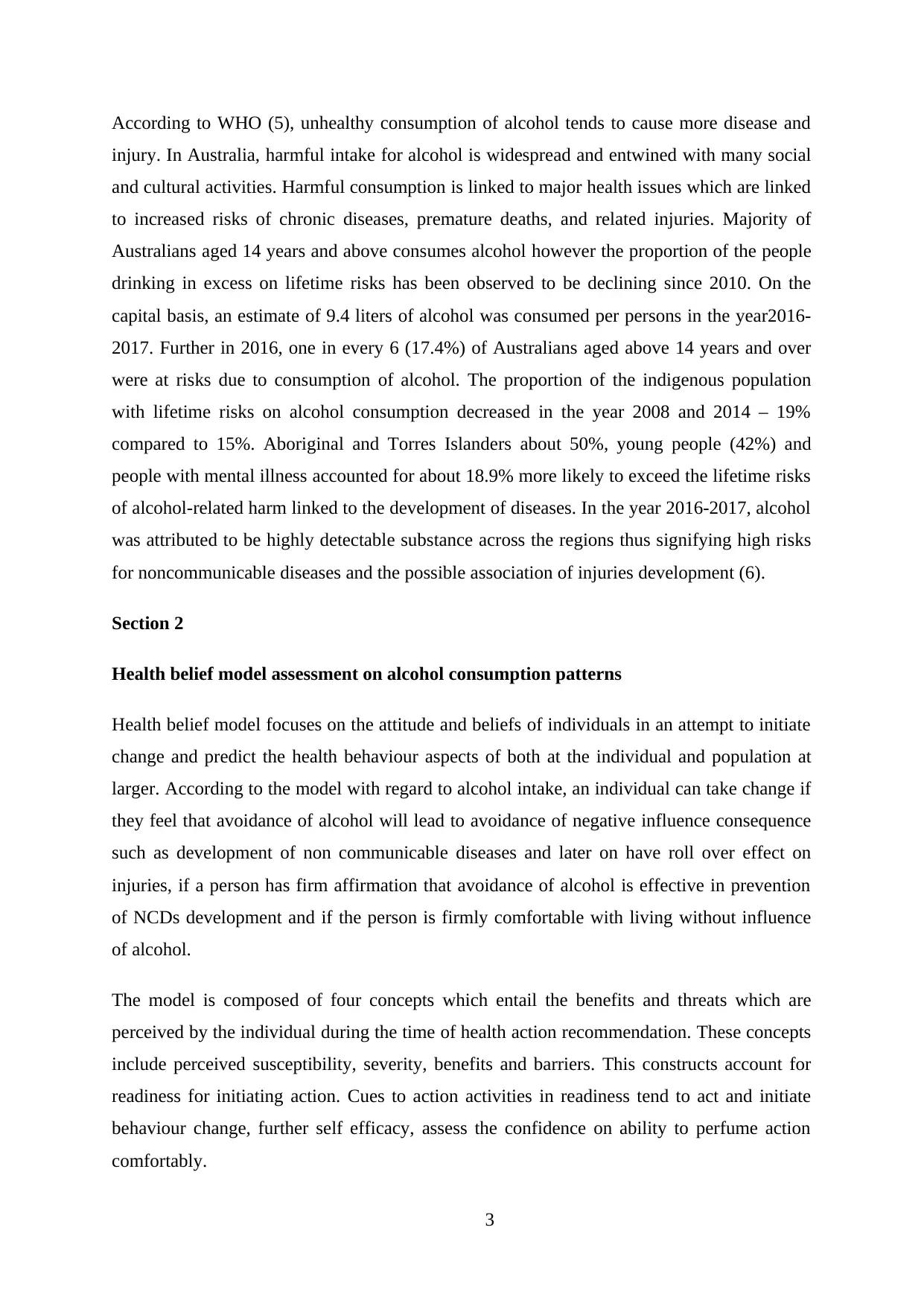
According to WHO (5), unhealthy consumption of alcohol tends to cause more disease and
injury. In Australia, harmful intake for alcohol is widespread and entwined with many social
and cultural activities. Harmful consumption is linked to major health issues which are linked
to increased risks of chronic diseases, premature deaths, and related injuries. Majority of
Australians aged 14 years and above consumes alcohol however the proportion of the people
drinking in excess on lifetime risks has been observed to be declining since 2010. On the
capital basis, an estimate of 9.4 liters of alcohol was consumed per persons in the year2016-
2017. Further in 2016, one in every 6 (17.4%) of Australians aged above 14 years and over
were at risks due to consumption of alcohol. The proportion of the indigenous population
with lifetime risks on alcohol consumption decreased in the year 2008 and 2014 – 19%
compared to 15%. Aboriginal and Torres Islanders about 50%, young people (42%) and
people with mental illness accounted for about 18.9% more likely to exceed the lifetime risks
of alcohol-related harm linked to the development of diseases. In the year 2016-2017, alcohol
was attributed to be highly detectable substance across the regions thus signifying high risks
for noncommunicable diseases and the possible association of injuries development (6).
Section 2
Health belief model assessment on alcohol consumption patterns
Health belief model focuses on the attitude and beliefs of individuals in an attempt to initiate
change and predict the health behaviour aspects of both at the individual and population at
larger. According to the model with regard to alcohol intake, an individual can take change if
they feel that avoidance of alcohol will lead to avoidance of negative influence consequence
such as development of non communicable diseases and later on have roll over effect on
injuries, if a person has firm affirmation that avoidance of alcohol is effective in prevention
of NCDs development and if the person is firmly comfortable with living without influence
of alcohol.
The model is composed of four concepts which entail the benefits and threats which are
perceived by the individual during the time of health action recommendation. These concepts
include perceived susceptibility, severity, benefits and barriers. This constructs account for
readiness for initiating action. Cues to action activities in readiness tend to act and initiate
behaviour change, further self efficacy, assess the confidence on ability to perfume action
comfortably.
3
injury. In Australia, harmful intake for alcohol is widespread and entwined with many social
and cultural activities. Harmful consumption is linked to major health issues which are linked
to increased risks of chronic diseases, premature deaths, and related injuries. Majority of
Australians aged 14 years and above consumes alcohol however the proportion of the people
drinking in excess on lifetime risks has been observed to be declining since 2010. On the
capital basis, an estimate of 9.4 liters of alcohol was consumed per persons in the year2016-
2017. Further in 2016, one in every 6 (17.4%) of Australians aged above 14 years and over
were at risks due to consumption of alcohol. The proportion of the indigenous population
with lifetime risks on alcohol consumption decreased in the year 2008 and 2014 – 19%
compared to 15%. Aboriginal and Torres Islanders about 50%, young people (42%) and
people with mental illness accounted for about 18.9% more likely to exceed the lifetime risks
of alcohol-related harm linked to the development of diseases. In the year 2016-2017, alcohol
was attributed to be highly detectable substance across the regions thus signifying high risks
for noncommunicable diseases and the possible association of injuries development (6).
Section 2
Health belief model assessment on alcohol consumption patterns
Health belief model focuses on the attitude and beliefs of individuals in an attempt to initiate
change and predict the health behaviour aspects of both at the individual and population at
larger. According to the model with regard to alcohol intake, an individual can take change if
they feel that avoidance of alcohol will lead to avoidance of negative influence consequence
such as development of non communicable diseases and later on have roll over effect on
injuries, if a person has firm affirmation that avoidance of alcohol is effective in prevention
of NCDs development and if the person is firmly comfortable with living without influence
of alcohol.
The model is composed of four concepts which entail the benefits and threats which are
perceived by the individual during the time of health action recommendation. These concepts
include perceived susceptibility, severity, benefits and barriers. This constructs account for
readiness for initiating action. Cues to action activities in readiness tend to act and initiate
behaviour change, further self efficacy, assess the confidence on ability to perfume action
comfortably.
3
⊘ This is a preview!⊘
Do you want full access?
Subscribe today to unlock all pages.

Trusted by 1+ million students worldwide
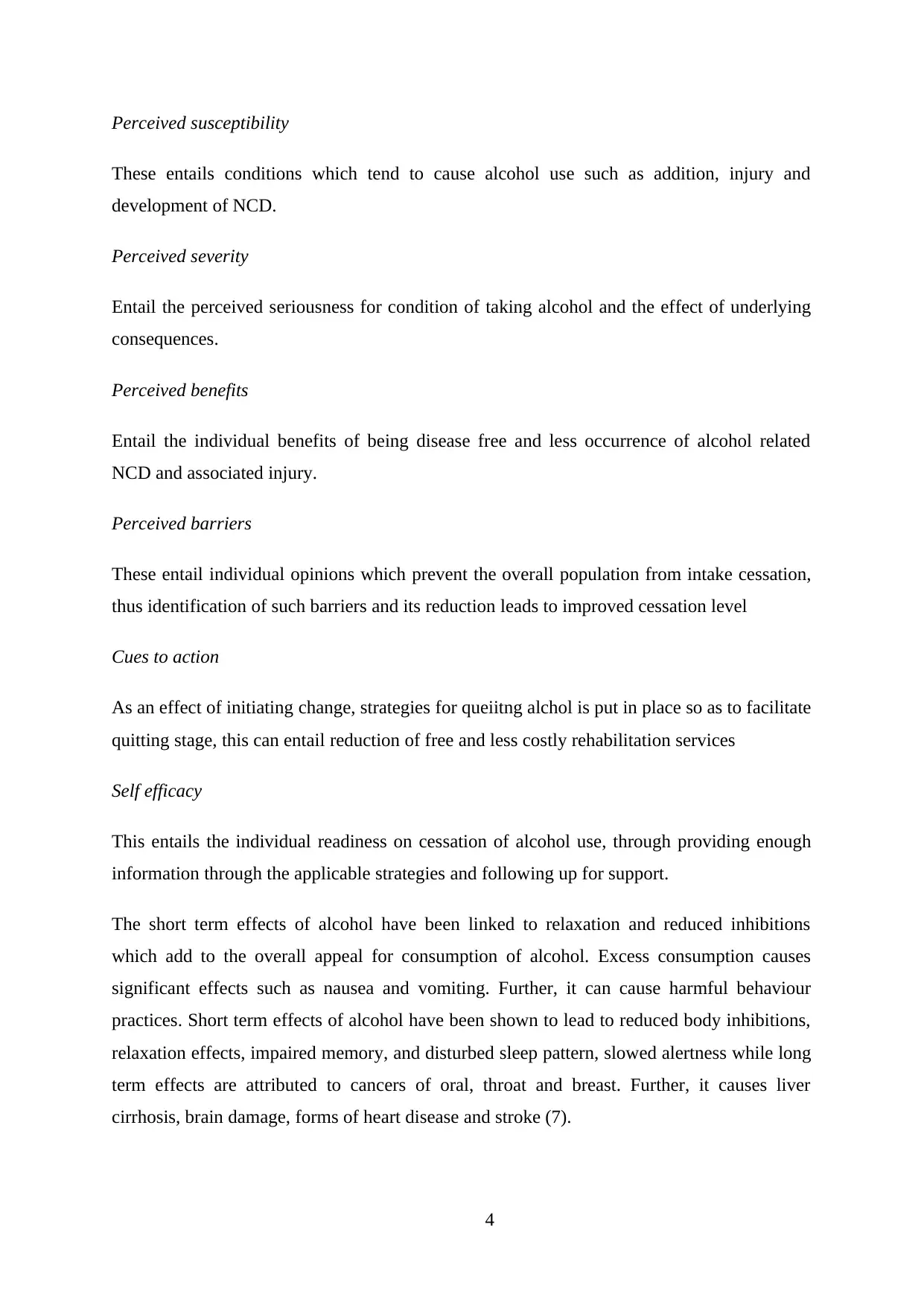
Perceived susceptibility
These entails conditions which tend to cause alcohol use such as addition, injury and
development of NCD.
Perceived severity
Entail the perceived seriousness for condition of taking alcohol and the effect of underlying
consequences.
Perceived benefits
Entail the individual benefits of being disease free and less occurrence of alcohol related
NCD and associated injury.
Perceived barriers
These entail individual opinions which prevent the overall population from intake cessation,
thus identification of such barriers and its reduction leads to improved cessation level
Cues to action
As an effect of initiating change, strategies for queiitng alchol is put in place so as to facilitate
quitting stage, this can entail reduction of free and less costly rehabilitation services
Self efficacy
This entails the individual readiness on cessation of alcohol use, through providing enough
information through the applicable strategies and following up for support.
The short term effects of alcohol have been linked to relaxation and reduced inhibitions
which add to the overall appeal for consumption of alcohol. Excess consumption causes
significant effects such as nausea and vomiting. Further, it can cause harmful behaviour
practices. Short term effects of alcohol have been shown to lead to reduced body inhibitions,
relaxation effects, impaired memory, and disturbed sleep pattern, slowed alertness while long
term effects are attributed to cancers of oral, throat and breast. Further, it causes liver
cirrhosis, brain damage, forms of heart disease and stroke (7).
4
These entails conditions which tend to cause alcohol use such as addition, injury and
development of NCD.
Perceived severity
Entail the perceived seriousness for condition of taking alcohol and the effect of underlying
consequences.
Perceived benefits
Entail the individual benefits of being disease free and less occurrence of alcohol related
NCD and associated injury.
Perceived barriers
These entail individual opinions which prevent the overall population from intake cessation,
thus identification of such barriers and its reduction leads to improved cessation level
Cues to action
As an effect of initiating change, strategies for queiitng alchol is put in place so as to facilitate
quitting stage, this can entail reduction of free and less costly rehabilitation services
Self efficacy
This entails the individual readiness on cessation of alcohol use, through providing enough
information through the applicable strategies and following up for support.
The short term effects of alcohol have been linked to relaxation and reduced inhibitions
which add to the overall appeal for consumption of alcohol. Excess consumption causes
significant effects such as nausea and vomiting. Further, it can cause harmful behaviour
practices. Short term effects of alcohol have been shown to lead to reduced body inhibitions,
relaxation effects, impaired memory, and disturbed sleep pattern, slowed alertness while long
term effects are attributed to cancers of oral, throat and breast. Further, it causes liver
cirrhosis, brain damage, forms of heart disease and stroke (7).
4
Paraphrase This Document
Need a fresh take? Get an instant paraphrase of this document with our AI Paraphraser
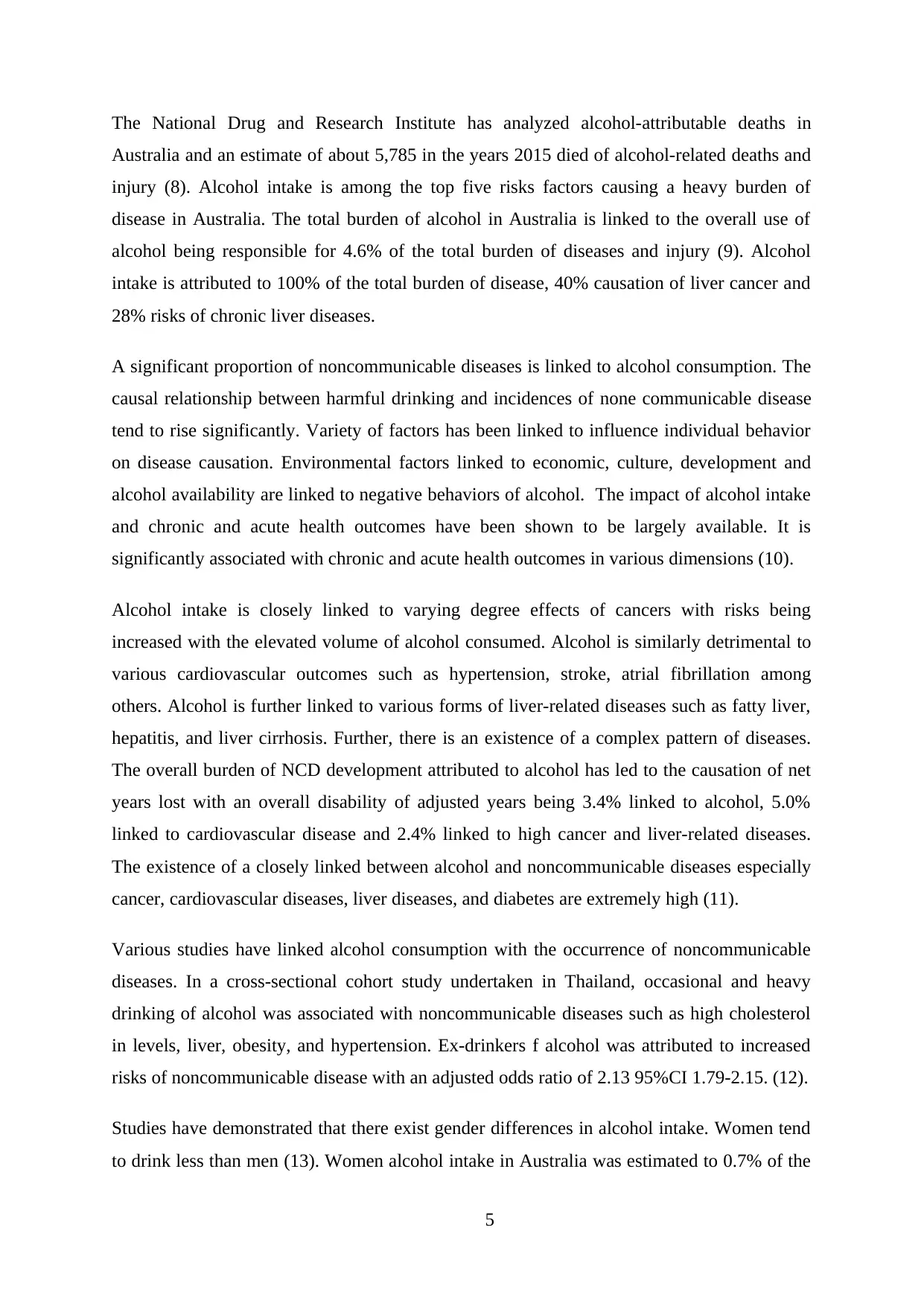
The National Drug and Research Institute has analyzed alcohol-attributable deaths in
Australia and an estimate of about 5,785 in the years 2015 died of alcohol-related deaths and
injury (8). Alcohol intake is among the top five risks factors causing a heavy burden of
disease in Australia. The total burden of alcohol in Australia is linked to the overall use of
alcohol being responsible for 4.6% of the total burden of diseases and injury (9). Alcohol
intake is attributed to 100% of the total burden of disease, 40% causation of liver cancer and
28% risks of chronic liver diseases.
A significant proportion of noncommunicable diseases is linked to alcohol consumption. The
causal relationship between harmful drinking and incidences of none communicable disease
tend to rise significantly. Variety of factors has been linked to influence individual behavior
on disease causation. Environmental factors linked to economic, culture, development and
alcohol availability are linked to negative behaviors of alcohol. The impact of alcohol intake
and chronic and acute health outcomes have been shown to be largely available. It is
significantly associated with chronic and acute health outcomes in various dimensions (10).
Alcohol intake is closely linked to varying degree effects of cancers with risks being
increased with the elevated volume of alcohol consumed. Alcohol is similarly detrimental to
various cardiovascular outcomes such as hypertension, stroke, atrial fibrillation among
others. Alcohol is further linked to various forms of liver-related diseases such as fatty liver,
hepatitis, and liver cirrhosis. Further, there is an existence of a complex pattern of diseases.
The overall burden of NCD development attributed to alcohol has led to the causation of net
years lost with an overall disability of adjusted years being 3.4% linked to alcohol, 5.0%
linked to cardiovascular disease and 2.4% linked to high cancer and liver-related diseases.
The existence of a closely linked between alcohol and noncommunicable diseases especially
cancer, cardiovascular diseases, liver diseases, and diabetes are extremely high (11).
Various studies have linked alcohol consumption with the occurrence of noncommunicable
diseases. In a cross-sectional cohort study undertaken in Thailand, occasional and heavy
drinking of alcohol was associated with noncommunicable diseases such as high cholesterol
in levels, liver, obesity, and hypertension. Ex-drinkers f alcohol was attributed to increased
risks of noncommunicable disease with an adjusted odds ratio of 2.13 95%CI 1.79-2.15. (12).
Studies have demonstrated that there exist gender differences in alcohol intake. Women tend
to drink less than men (13). Women alcohol intake in Australia was estimated to 0.7% of the
5
Australia and an estimate of about 5,785 in the years 2015 died of alcohol-related deaths and
injury (8). Alcohol intake is among the top five risks factors causing a heavy burden of
disease in Australia. The total burden of alcohol in Australia is linked to the overall use of
alcohol being responsible for 4.6% of the total burden of diseases and injury (9). Alcohol
intake is attributed to 100% of the total burden of disease, 40% causation of liver cancer and
28% risks of chronic liver diseases.
A significant proportion of noncommunicable diseases is linked to alcohol consumption. The
causal relationship between harmful drinking and incidences of none communicable disease
tend to rise significantly. Variety of factors has been linked to influence individual behavior
on disease causation. Environmental factors linked to economic, culture, development and
alcohol availability are linked to negative behaviors of alcohol. The impact of alcohol intake
and chronic and acute health outcomes have been shown to be largely available. It is
significantly associated with chronic and acute health outcomes in various dimensions (10).
Alcohol intake is closely linked to varying degree effects of cancers with risks being
increased with the elevated volume of alcohol consumed. Alcohol is similarly detrimental to
various cardiovascular outcomes such as hypertension, stroke, atrial fibrillation among
others. Alcohol is further linked to various forms of liver-related diseases such as fatty liver,
hepatitis, and liver cirrhosis. Further, there is an existence of a complex pattern of diseases.
The overall burden of NCD development attributed to alcohol has led to the causation of net
years lost with an overall disability of adjusted years being 3.4% linked to alcohol, 5.0%
linked to cardiovascular disease and 2.4% linked to high cancer and liver-related diseases.
The existence of a closely linked between alcohol and noncommunicable diseases especially
cancer, cardiovascular diseases, liver diseases, and diabetes are extremely high (11).
Various studies have linked alcohol consumption with the occurrence of noncommunicable
diseases. In a cross-sectional cohort study undertaken in Thailand, occasional and heavy
drinking of alcohol was associated with noncommunicable diseases such as high cholesterol
in levels, liver, obesity, and hypertension. Ex-drinkers f alcohol was attributed to increased
risks of noncommunicable disease with an adjusted odds ratio of 2.13 95%CI 1.79-2.15. (12).
Studies have demonstrated that there exist gender differences in alcohol intake. Women tend
to drink less than men (13). Women alcohol intake in Australia was estimated to 0.7% of the
5
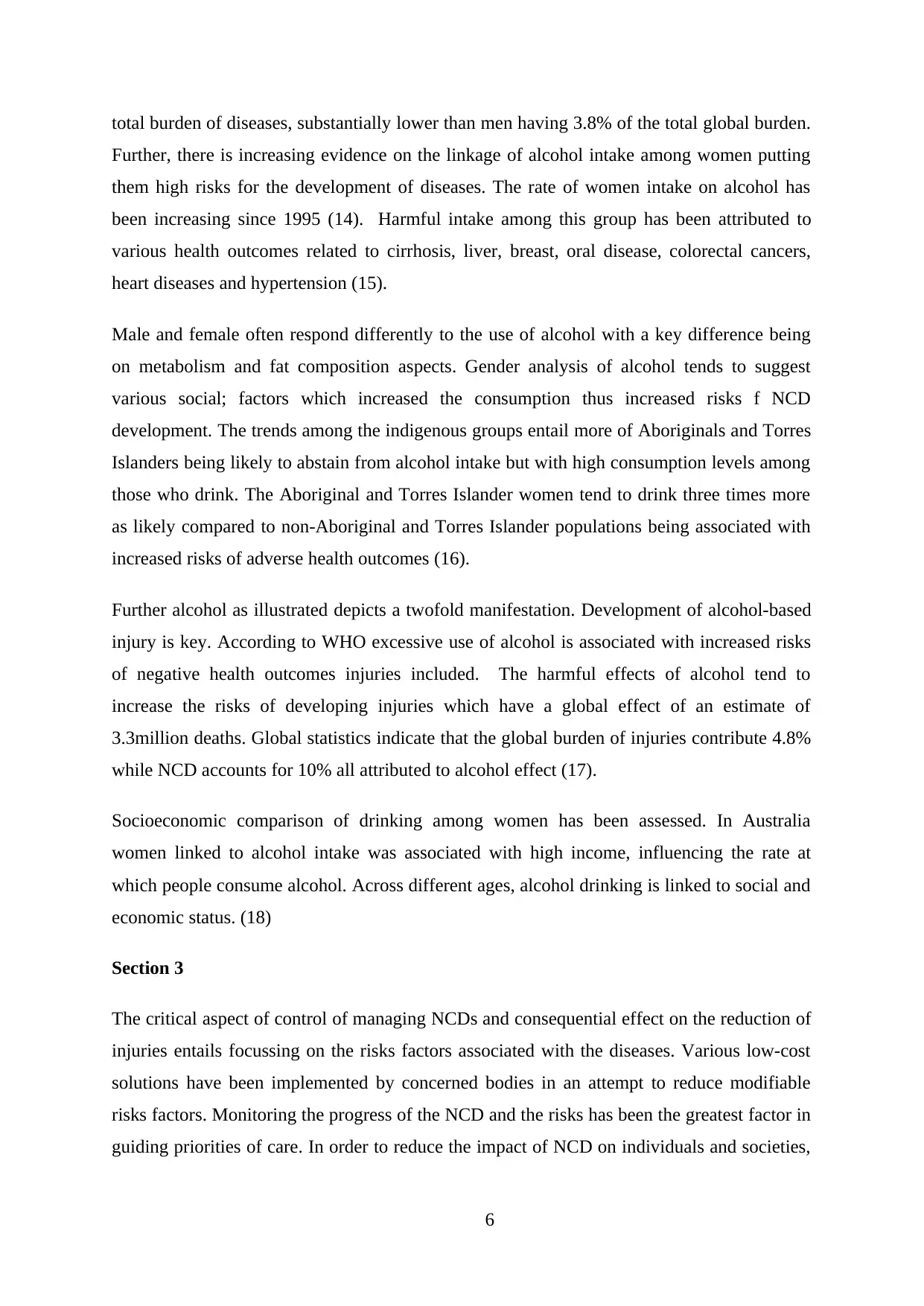
total burden of diseases, substantially lower than men having 3.8% of the total global burden.
Further, there is increasing evidence on the linkage of alcohol intake among women putting
them high risks for the development of diseases. The rate of women intake on alcohol has
been increasing since 1995 (14). Harmful intake among this group has been attributed to
various health outcomes related to cirrhosis, liver, breast, oral disease, colorectal cancers,
heart diseases and hypertension (15).
Male and female often respond differently to the use of alcohol with a key difference being
on metabolism and fat composition aspects. Gender analysis of alcohol tends to suggest
various social; factors which increased the consumption thus increased risks f NCD
development. The trends among the indigenous groups entail more of Aboriginals and Torres
Islanders being likely to abstain from alcohol intake but with high consumption levels among
those who drink. The Aboriginal and Torres Islander women tend to drink three times more
as likely compared to non-Aboriginal and Torres Islander populations being associated with
increased risks of adverse health outcomes (16).
Further alcohol as illustrated depicts a twofold manifestation. Development of alcohol-based
injury is key. According to WHO excessive use of alcohol is associated with increased risks
of negative health outcomes injuries included. The harmful effects of alcohol tend to
increase the risks of developing injuries which have a global effect of an estimate of
3.3million deaths. Global statistics indicate that the global burden of injuries contribute 4.8%
while NCD accounts for 10% all attributed to alcohol effect (17).
Socioeconomic comparison of drinking among women has been assessed. In Australia
women linked to alcohol intake was associated with high income, influencing the rate at
which people consume alcohol. Across different ages, alcohol drinking is linked to social and
economic status. (18)
Section 3
The critical aspect of control of managing NCDs and consequential effect on the reduction of
injuries entails focussing on the risks factors associated with the diseases. Various low-cost
solutions have been implemented by concerned bodies in an attempt to reduce modifiable
risks factors. Monitoring the progress of the NCD and the risks has been the greatest factor in
guiding priorities of care. In order to reduce the impact of NCD on individuals and societies,
6
Further, there is increasing evidence on the linkage of alcohol intake among women putting
them high risks for the development of diseases. The rate of women intake on alcohol has
been increasing since 1995 (14). Harmful intake among this group has been attributed to
various health outcomes related to cirrhosis, liver, breast, oral disease, colorectal cancers,
heart diseases and hypertension (15).
Male and female often respond differently to the use of alcohol with a key difference being
on metabolism and fat composition aspects. Gender analysis of alcohol tends to suggest
various social; factors which increased the consumption thus increased risks f NCD
development. The trends among the indigenous groups entail more of Aboriginals and Torres
Islanders being likely to abstain from alcohol intake but with high consumption levels among
those who drink. The Aboriginal and Torres Islander women tend to drink three times more
as likely compared to non-Aboriginal and Torres Islander populations being associated with
increased risks of adverse health outcomes (16).
Further alcohol as illustrated depicts a twofold manifestation. Development of alcohol-based
injury is key. According to WHO excessive use of alcohol is associated with increased risks
of negative health outcomes injuries included. The harmful effects of alcohol tend to
increase the risks of developing injuries which have a global effect of an estimate of
3.3million deaths. Global statistics indicate that the global burden of injuries contribute 4.8%
while NCD accounts for 10% all attributed to alcohol effect (17).
Socioeconomic comparison of drinking among women has been assessed. In Australia
women linked to alcohol intake was associated with high income, influencing the rate at
which people consume alcohol. Across different ages, alcohol drinking is linked to social and
economic status. (18)
Section 3
The critical aspect of control of managing NCDs and consequential effect on the reduction of
injuries entails focussing on the risks factors associated with the diseases. Various low-cost
solutions have been implemented by concerned bodies in an attempt to reduce modifiable
risks factors. Monitoring the progress of the NCD and the risks has been the greatest factor in
guiding priorities of care. In order to reduce the impact of NCD on individuals and societies,
6
⊘ This is a preview!⊘
Do you want full access?
Subscribe today to unlock all pages.

Trusted by 1+ million students worldwide
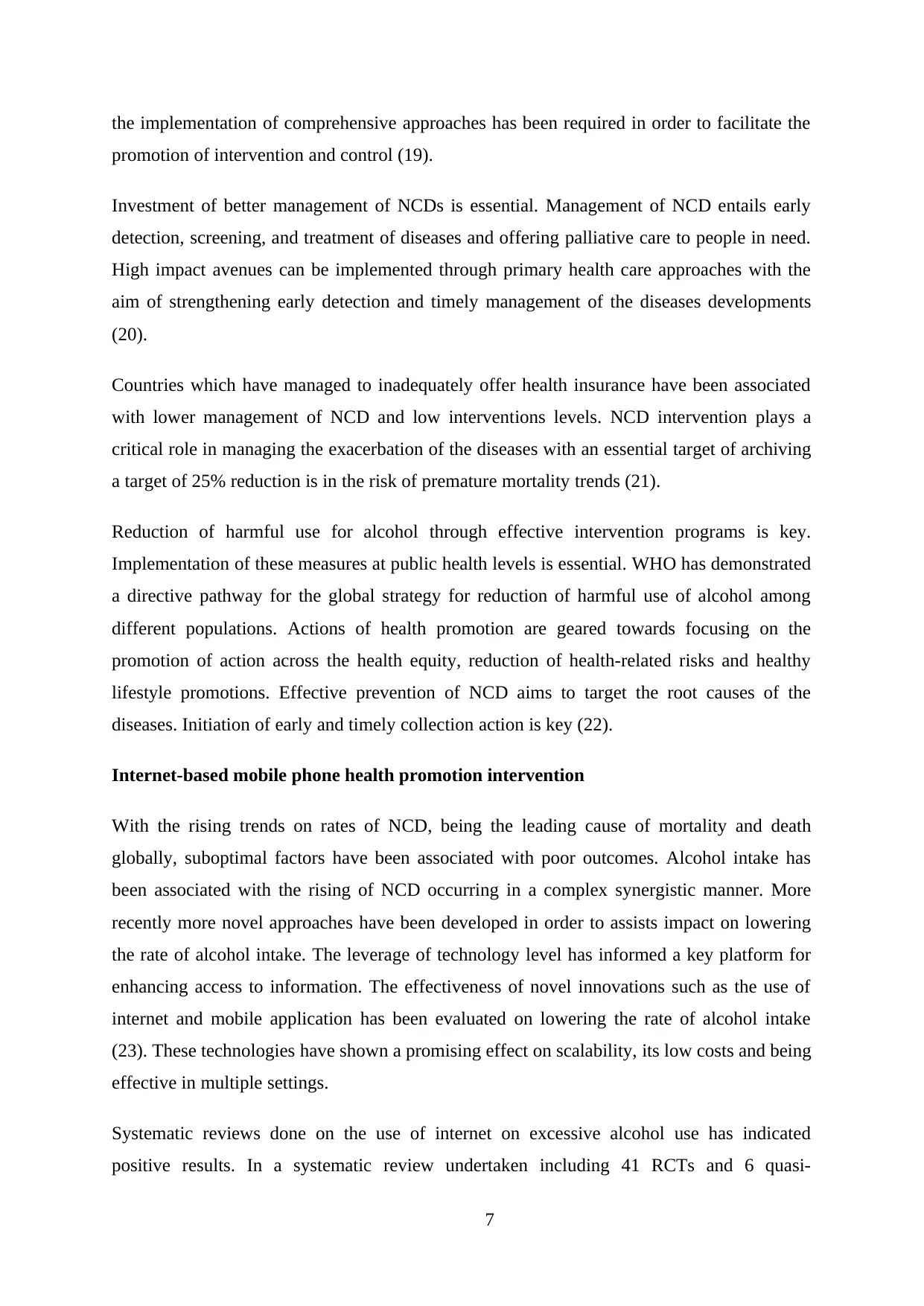
the implementation of comprehensive approaches has been required in order to facilitate the
promotion of intervention and control (19).
Investment of better management of NCDs is essential. Management of NCD entails early
detection, screening, and treatment of diseases and offering palliative care to people in need.
High impact avenues can be implemented through primary health care approaches with the
aim of strengthening early detection and timely management of the diseases developments
(20).
Countries which have managed to inadequately offer health insurance have been associated
with lower management of NCD and low interventions levels. NCD intervention plays a
critical role in managing the exacerbation of the diseases with an essential target of archiving
a target of 25% reduction is in the risk of premature mortality trends (21).
Reduction of harmful use for alcohol through effective intervention programs is key.
Implementation of these measures at public health levels is essential. WHO has demonstrated
a directive pathway for the global strategy for reduction of harmful use of alcohol among
different populations. Actions of health promotion are geared towards focusing on the
promotion of action across the health equity, reduction of health-related risks and healthy
lifestyle promotions. Effective prevention of NCD aims to target the root causes of the
diseases. Initiation of early and timely collection action is key (22).
Internet-based mobile phone health promotion intervention
With the rising trends on rates of NCD, being the leading cause of mortality and death
globally, suboptimal factors have been associated with poor outcomes. Alcohol intake has
been associated with the rising of NCD occurring in a complex synergistic manner. More
recently more novel approaches have been developed in order to assists impact on lowering
the rate of alcohol intake. The leverage of technology level has informed a key platform for
enhancing access to information. The effectiveness of novel innovations such as the use of
internet and mobile application has been evaluated on lowering the rate of alcohol intake
(23). These technologies have shown a promising effect on scalability, its low costs and being
effective in multiple settings.
Systematic reviews done on the use of internet on excessive alcohol use has indicated
positive results. In a systematic review undertaken including 41 RCTs and 6 quasi-
7
promotion of intervention and control (19).
Investment of better management of NCDs is essential. Management of NCD entails early
detection, screening, and treatment of diseases and offering palliative care to people in need.
High impact avenues can be implemented through primary health care approaches with the
aim of strengthening early detection and timely management of the diseases developments
(20).
Countries which have managed to inadequately offer health insurance have been associated
with lower management of NCD and low interventions levels. NCD intervention plays a
critical role in managing the exacerbation of the diseases with an essential target of archiving
a target of 25% reduction is in the risk of premature mortality trends (21).
Reduction of harmful use for alcohol through effective intervention programs is key.
Implementation of these measures at public health levels is essential. WHO has demonstrated
a directive pathway for the global strategy for reduction of harmful use of alcohol among
different populations. Actions of health promotion are geared towards focusing on the
promotion of action across the health equity, reduction of health-related risks and healthy
lifestyle promotions. Effective prevention of NCD aims to target the root causes of the
diseases. Initiation of early and timely collection action is key (22).
Internet-based mobile phone health promotion intervention
With the rising trends on rates of NCD, being the leading cause of mortality and death
globally, suboptimal factors have been associated with poor outcomes. Alcohol intake has
been associated with the rising of NCD occurring in a complex synergistic manner. More
recently more novel approaches have been developed in order to assists impact on lowering
the rate of alcohol intake. The leverage of technology level has informed a key platform for
enhancing access to information. The effectiveness of novel innovations such as the use of
internet and mobile application has been evaluated on lowering the rate of alcohol intake
(23). These technologies have shown a promising effect on scalability, its low costs and being
effective in multiple settings.
Systematic reviews done on the use of internet on excessive alcohol use has indicated
positive results. In a systematic review undertaken including 41 RCTs and 6 quasi-
7
Paraphrase This Document
Need a fresh take? Get an instant paraphrase of this document with our AI Paraphraser
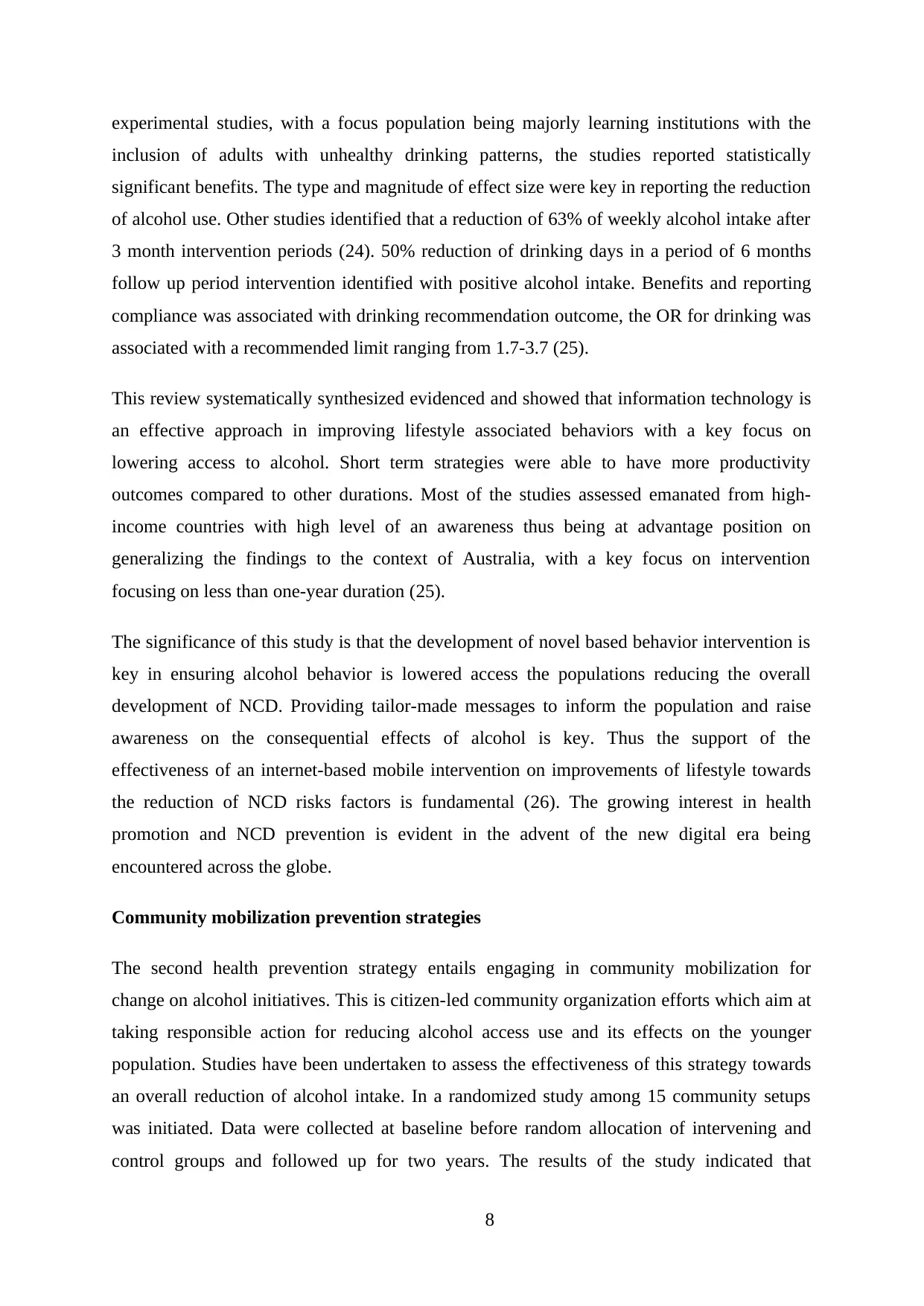
experimental studies, with a focus population being majorly learning institutions with the
inclusion of adults with unhealthy drinking patterns, the studies reported statistically
significant benefits. The type and magnitude of effect size were key in reporting the reduction
of alcohol use. Other studies identified that a reduction of 63% of weekly alcohol intake after
3 month intervention periods (24). 50% reduction of drinking days in a period of 6 months
follow up period intervention identified with positive alcohol intake. Benefits and reporting
compliance was associated with drinking recommendation outcome, the OR for drinking was
associated with a recommended limit ranging from 1.7-3.7 (25).
This review systematically synthesized evidenced and showed that information technology is
an effective approach in improving lifestyle associated behaviors with a key focus on
lowering access to alcohol. Short term strategies were able to have more productivity
outcomes compared to other durations. Most of the studies assessed emanated from high-
income countries with high level of an awareness thus being at advantage position on
generalizing the findings to the context of Australia, with a key focus on intervention
focusing on less than one-year duration (25).
The significance of this study is that the development of novel based behavior intervention is
key in ensuring alcohol behavior is lowered access the populations reducing the overall
development of NCD. Providing tailor-made messages to inform the population and raise
awareness on the consequential effects of alcohol is key. Thus the support of the
effectiveness of an internet-based mobile intervention on improvements of lifestyle towards
the reduction of NCD risks factors is fundamental (26). The growing interest in health
promotion and NCD prevention is evident in the advent of the new digital era being
encountered across the globe.
Community mobilization prevention strategies
The second health prevention strategy entails engaging in community mobilization for
change on alcohol initiatives. This is citizen-led community organization efforts which aim at
taking responsible action for reducing alcohol access use and its effects on the younger
population. Studies have been undertaken to assess the effectiveness of this strategy towards
an overall reduction of alcohol intake. In a randomized study among 15 community setups
was initiated. Data were collected at baseline before random allocation of intervening and
control groups and followed up for two years. The results of the study indicated that
8
inclusion of adults with unhealthy drinking patterns, the studies reported statistically
significant benefits. The type and magnitude of effect size were key in reporting the reduction
of alcohol use. Other studies identified that a reduction of 63% of weekly alcohol intake after
3 month intervention periods (24). 50% reduction of drinking days in a period of 6 months
follow up period intervention identified with positive alcohol intake. Benefits and reporting
compliance was associated with drinking recommendation outcome, the OR for drinking was
associated with a recommended limit ranging from 1.7-3.7 (25).
This review systematically synthesized evidenced and showed that information technology is
an effective approach in improving lifestyle associated behaviors with a key focus on
lowering access to alcohol. Short term strategies were able to have more productivity
outcomes compared to other durations. Most of the studies assessed emanated from high-
income countries with high level of an awareness thus being at advantage position on
generalizing the findings to the context of Australia, with a key focus on intervention
focusing on less than one-year duration (25).
The significance of this study is that the development of novel based behavior intervention is
key in ensuring alcohol behavior is lowered access the populations reducing the overall
development of NCD. Providing tailor-made messages to inform the population and raise
awareness on the consequential effects of alcohol is key. Thus the support of the
effectiveness of an internet-based mobile intervention on improvements of lifestyle towards
the reduction of NCD risks factors is fundamental (26). The growing interest in health
promotion and NCD prevention is evident in the advent of the new digital era being
encountered across the globe.
Community mobilization prevention strategies
The second health prevention strategy entails engaging in community mobilization for
change on alcohol initiatives. This is citizen-led community organization efforts which aim at
taking responsible action for reducing alcohol access use and its effects on the younger
population. Studies have been undertaken to assess the effectiveness of this strategy towards
an overall reduction of alcohol intake. In a randomized study among 15 community setups
was initiated. Data were collected at baseline before random allocation of intervening and
control groups and followed up for two years. The results of the study indicated that
8
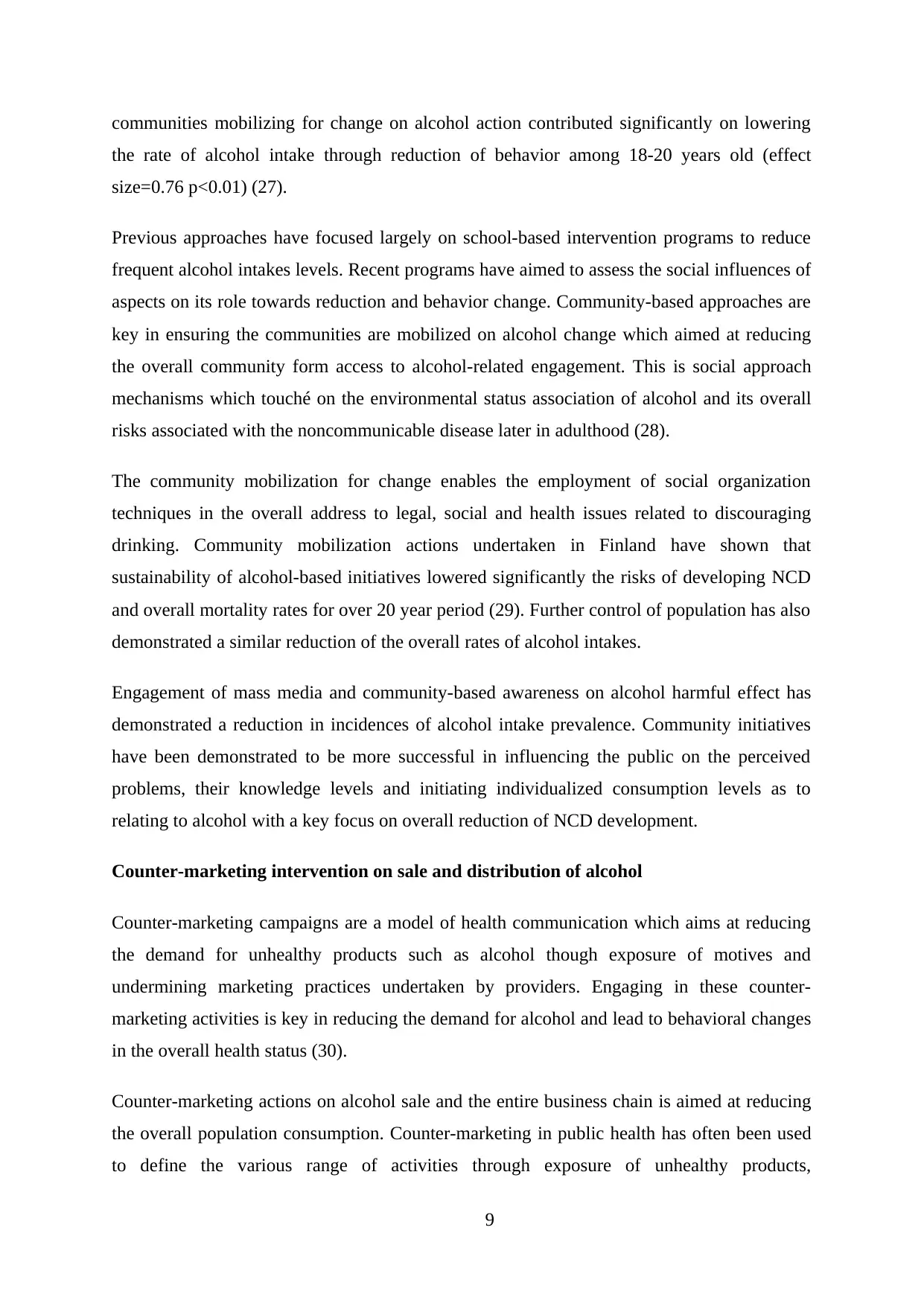
communities mobilizing for change on alcohol action contributed significantly on lowering
the rate of alcohol intake through reduction of behavior among 18-20 years old (effect
size=0.76 p<0.01) (27).
Previous approaches have focused largely on school-based intervention programs to reduce
frequent alcohol intakes levels. Recent programs have aimed to assess the social influences of
aspects on its role towards reduction and behavior change. Community-based approaches are
key in ensuring the communities are mobilized on alcohol change which aimed at reducing
the overall community form access to alcohol-related engagement. This is social approach
mechanisms which touché on the environmental status association of alcohol and its overall
risks associated with the noncommunicable disease later in adulthood (28).
The community mobilization for change enables the employment of social organization
techniques in the overall address to legal, social and health issues related to discouraging
drinking. Community mobilization actions undertaken in Finland have shown that
sustainability of alcohol-based initiatives lowered significantly the risks of developing NCD
and overall mortality rates for over 20 year period (29). Further control of population has also
demonstrated a similar reduction of the overall rates of alcohol intakes.
Engagement of mass media and community-based awareness on alcohol harmful effect has
demonstrated a reduction in incidences of alcohol intake prevalence. Community initiatives
have been demonstrated to be more successful in influencing the public on the perceived
problems, their knowledge levels and initiating individualized consumption levels as to
relating to alcohol with a key focus on overall reduction of NCD development.
Counter-marketing intervention on sale and distribution of alcohol
Counter-marketing campaigns are a model of health communication which aims at reducing
the demand for unhealthy products such as alcohol though exposure of motives and
undermining marketing practices undertaken by providers. Engaging in these counter-
marketing activities is key in reducing the demand for alcohol and lead to behavioral changes
in the overall health status (30).
Counter-marketing actions on alcohol sale and the entire business chain is aimed at reducing
the overall population consumption. Counter-marketing in public health has often been used
to define the various range of activities through exposure of unhealthy products,
9
the rate of alcohol intake through reduction of behavior among 18-20 years old (effect
size=0.76 p<0.01) (27).
Previous approaches have focused largely on school-based intervention programs to reduce
frequent alcohol intakes levels. Recent programs have aimed to assess the social influences of
aspects on its role towards reduction and behavior change. Community-based approaches are
key in ensuring the communities are mobilized on alcohol change which aimed at reducing
the overall community form access to alcohol-related engagement. This is social approach
mechanisms which touché on the environmental status association of alcohol and its overall
risks associated with the noncommunicable disease later in adulthood (28).
The community mobilization for change enables the employment of social organization
techniques in the overall address to legal, social and health issues related to discouraging
drinking. Community mobilization actions undertaken in Finland have shown that
sustainability of alcohol-based initiatives lowered significantly the risks of developing NCD
and overall mortality rates for over 20 year period (29). Further control of population has also
demonstrated a similar reduction of the overall rates of alcohol intakes.
Engagement of mass media and community-based awareness on alcohol harmful effect has
demonstrated a reduction in incidences of alcohol intake prevalence. Community initiatives
have been demonstrated to be more successful in influencing the public on the perceived
problems, their knowledge levels and initiating individualized consumption levels as to
relating to alcohol with a key focus on overall reduction of NCD development.
Counter-marketing intervention on sale and distribution of alcohol
Counter-marketing campaigns are a model of health communication which aims at reducing
the demand for unhealthy products such as alcohol though exposure of motives and
undermining marketing practices undertaken by providers. Engaging in these counter-
marketing activities is key in reducing the demand for alcohol and lead to behavioral changes
in the overall health status (30).
Counter-marketing actions on alcohol sale and the entire business chain is aimed at reducing
the overall population consumption. Counter-marketing in public health has often been used
to define the various range of activities through exposure of unhealthy products,
9
⊘ This is a preview!⊘
Do you want full access?
Subscribe today to unlock all pages.

Trusted by 1+ million students worldwide
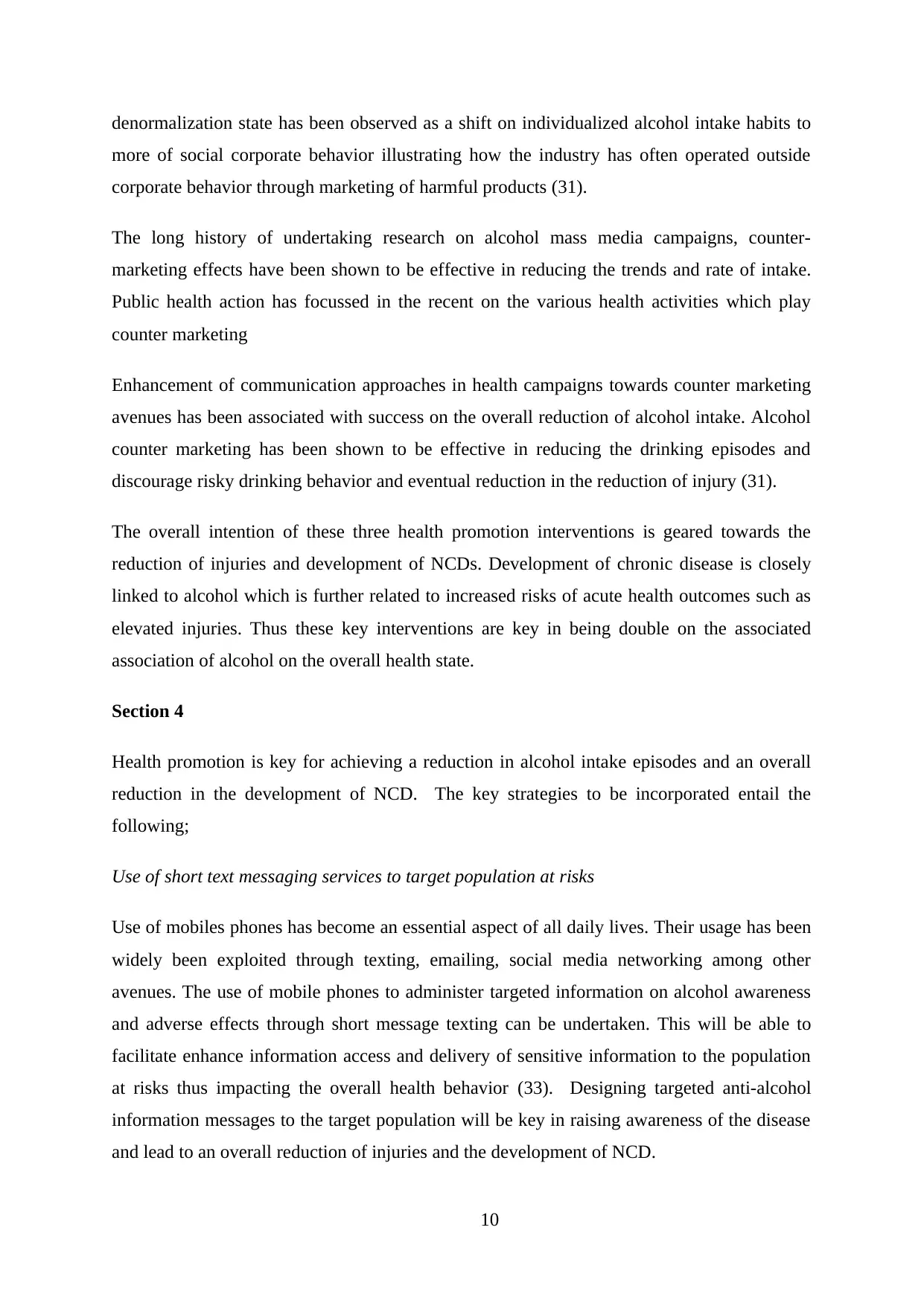
denormalization state has been observed as a shift on individualized alcohol intake habits to
more of social corporate behavior illustrating how the industry has often operated outside
corporate behavior through marketing of harmful products (31).
The long history of undertaking research on alcohol mass media campaigns, counter-
marketing effects have been shown to be effective in reducing the trends and rate of intake.
Public health action has focussed in the recent on the various health activities which play
counter marketing
Enhancement of communication approaches in health campaigns towards counter marketing
avenues has been associated with success on the overall reduction of alcohol intake. Alcohol
counter marketing has been shown to be effective in reducing the drinking episodes and
discourage risky drinking behavior and eventual reduction in the reduction of injury (31).
The overall intention of these three health promotion interventions is geared towards the
reduction of injuries and development of NCDs. Development of chronic disease is closely
linked to alcohol which is further related to increased risks of acute health outcomes such as
elevated injuries. Thus these key interventions are key in being double on the associated
association of alcohol on the overall health state.
Section 4
Health promotion is key for achieving a reduction in alcohol intake episodes and an overall
reduction in the development of NCD. The key strategies to be incorporated entail the
following;
Use of short text messaging services to target population at risks
Use of mobiles phones has become an essential aspect of all daily lives. Their usage has been
widely been exploited through texting, emailing, social media networking among other
avenues. The use of mobile phones to administer targeted information on alcohol awareness
and adverse effects through short message texting can be undertaken. This will be able to
facilitate enhance information access and delivery of sensitive information to the population
at risks thus impacting the overall health behavior (33). Designing targeted anti-alcohol
information messages to the target population will be key in raising awareness of the disease
and lead to an overall reduction of injuries and the development of NCD.
10
more of social corporate behavior illustrating how the industry has often operated outside
corporate behavior through marketing of harmful products (31).
The long history of undertaking research on alcohol mass media campaigns, counter-
marketing effects have been shown to be effective in reducing the trends and rate of intake.
Public health action has focussed in the recent on the various health activities which play
counter marketing
Enhancement of communication approaches in health campaigns towards counter marketing
avenues has been associated with success on the overall reduction of alcohol intake. Alcohol
counter marketing has been shown to be effective in reducing the drinking episodes and
discourage risky drinking behavior and eventual reduction in the reduction of injury (31).
The overall intention of these three health promotion interventions is geared towards the
reduction of injuries and development of NCDs. Development of chronic disease is closely
linked to alcohol which is further related to increased risks of acute health outcomes such as
elevated injuries. Thus these key interventions are key in being double on the associated
association of alcohol on the overall health state.
Section 4
Health promotion is key for achieving a reduction in alcohol intake episodes and an overall
reduction in the development of NCD. The key strategies to be incorporated entail the
following;
Use of short text messaging services to target population at risks
Use of mobiles phones has become an essential aspect of all daily lives. Their usage has been
widely been exploited through texting, emailing, social media networking among other
avenues. The use of mobile phones to administer targeted information on alcohol awareness
and adverse effects through short message texting can be undertaken. This will be able to
facilitate enhance information access and delivery of sensitive information to the population
at risks thus impacting the overall health behavior (33). Designing targeted anti-alcohol
information messages to the target population will be key in raising awareness of the disease
and lead to an overall reduction of injuries and the development of NCD.
10
Paraphrase This Document
Need a fresh take? Get an instant paraphrase of this document with our AI Paraphraser
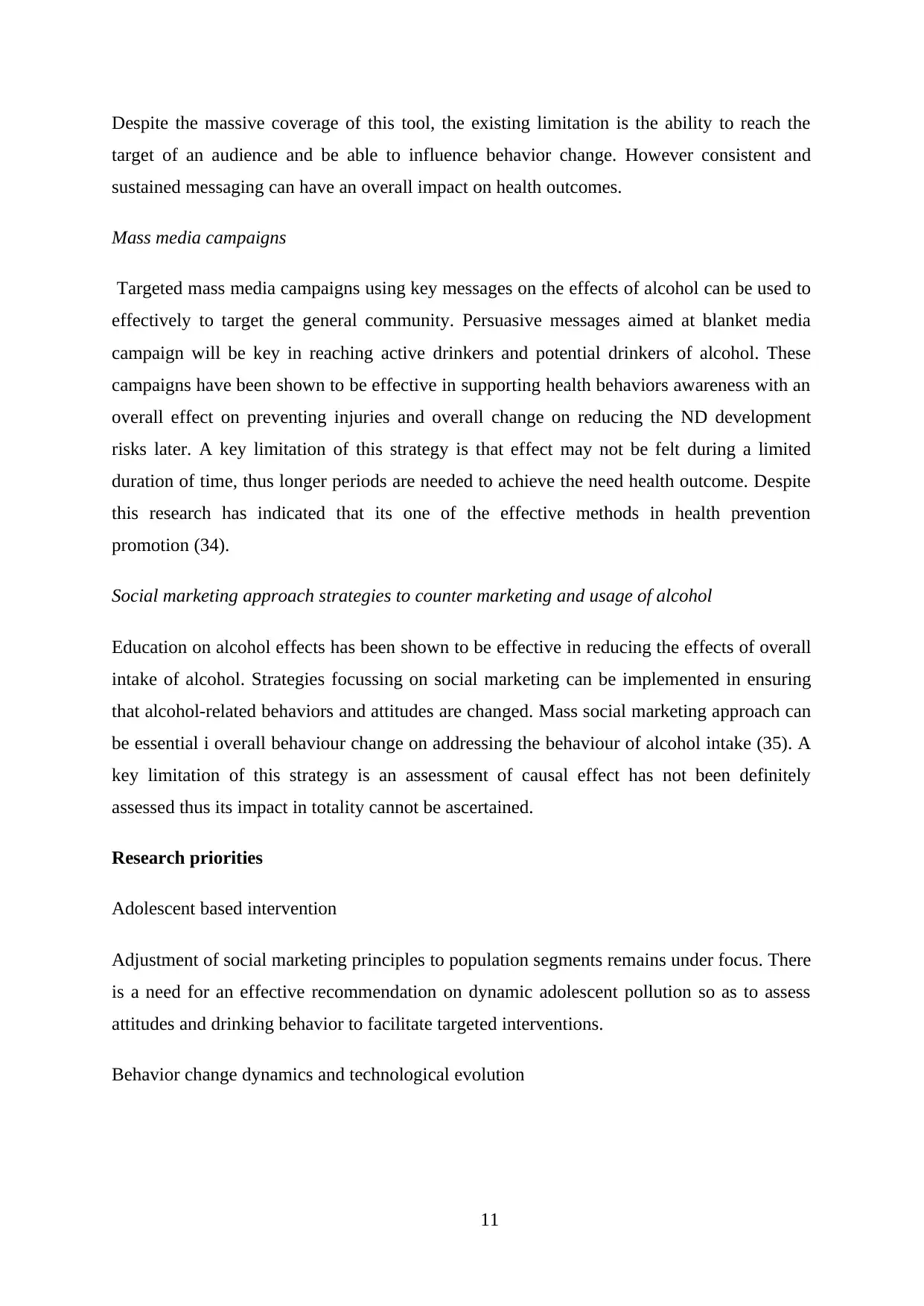
Despite the massive coverage of this tool, the existing limitation is the ability to reach the
target of an audience and be able to influence behavior change. However consistent and
sustained messaging can have an overall impact on health outcomes.
Mass media campaigns
Targeted mass media campaigns using key messages on the effects of alcohol can be used to
effectively to target the general community. Persuasive messages aimed at blanket media
campaign will be key in reaching active drinkers and potential drinkers of alcohol. These
campaigns have been shown to be effective in supporting health behaviors awareness with an
overall effect on preventing injuries and overall change on reducing the ND development
risks later. A key limitation of this strategy is that effect may not be felt during a limited
duration of time, thus longer periods are needed to achieve the need health outcome. Despite
this research has indicated that its one of the effective methods in health prevention
promotion (34).
Social marketing approach strategies to counter marketing and usage of alcohol
Education on alcohol effects has been shown to be effective in reducing the effects of overall
intake of alcohol. Strategies focussing on social marketing can be implemented in ensuring
that alcohol-related behaviors and attitudes are changed. Mass social marketing approach can
be essential i overall behaviour change on addressing the behaviour of alcohol intake (35). A
key limitation of this strategy is an assessment of causal effect has not been definitely
assessed thus its impact in totality cannot be ascertained.
Research priorities
Adolescent based intervention
Adjustment of social marketing principles to population segments remains under focus. There
is a need for an effective recommendation on dynamic adolescent pollution so as to assess
attitudes and drinking behavior to facilitate targeted interventions.
Behavior change dynamics and technological evolution
11
target of an audience and be able to influence behavior change. However consistent and
sustained messaging can have an overall impact on health outcomes.
Mass media campaigns
Targeted mass media campaigns using key messages on the effects of alcohol can be used to
effectively to target the general community. Persuasive messages aimed at blanket media
campaign will be key in reaching active drinkers and potential drinkers of alcohol. These
campaigns have been shown to be effective in supporting health behaviors awareness with an
overall effect on preventing injuries and overall change on reducing the ND development
risks later. A key limitation of this strategy is that effect may not be felt during a limited
duration of time, thus longer periods are needed to achieve the need health outcome. Despite
this research has indicated that its one of the effective methods in health prevention
promotion (34).
Social marketing approach strategies to counter marketing and usage of alcohol
Education on alcohol effects has been shown to be effective in reducing the effects of overall
intake of alcohol. Strategies focussing on social marketing can be implemented in ensuring
that alcohol-related behaviors and attitudes are changed. Mass social marketing approach can
be essential i overall behaviour change on addressing the behaviour of alcohol intake (35). A
key limitation of this strategy is an assessment of causal effect has not been definitely
assessed thus its impact in totality cannot be ascertained.
Research priorities
Adolescent based intervention
Adjustment of social marketing principles to population segments remains under focus. There
is a need for an effective recommendation on dynamic adolescent pollution so as to assess
attitudes and drinking behavior to facilitate targeted interventions.
Behavior change dynamics and technological evolution
11
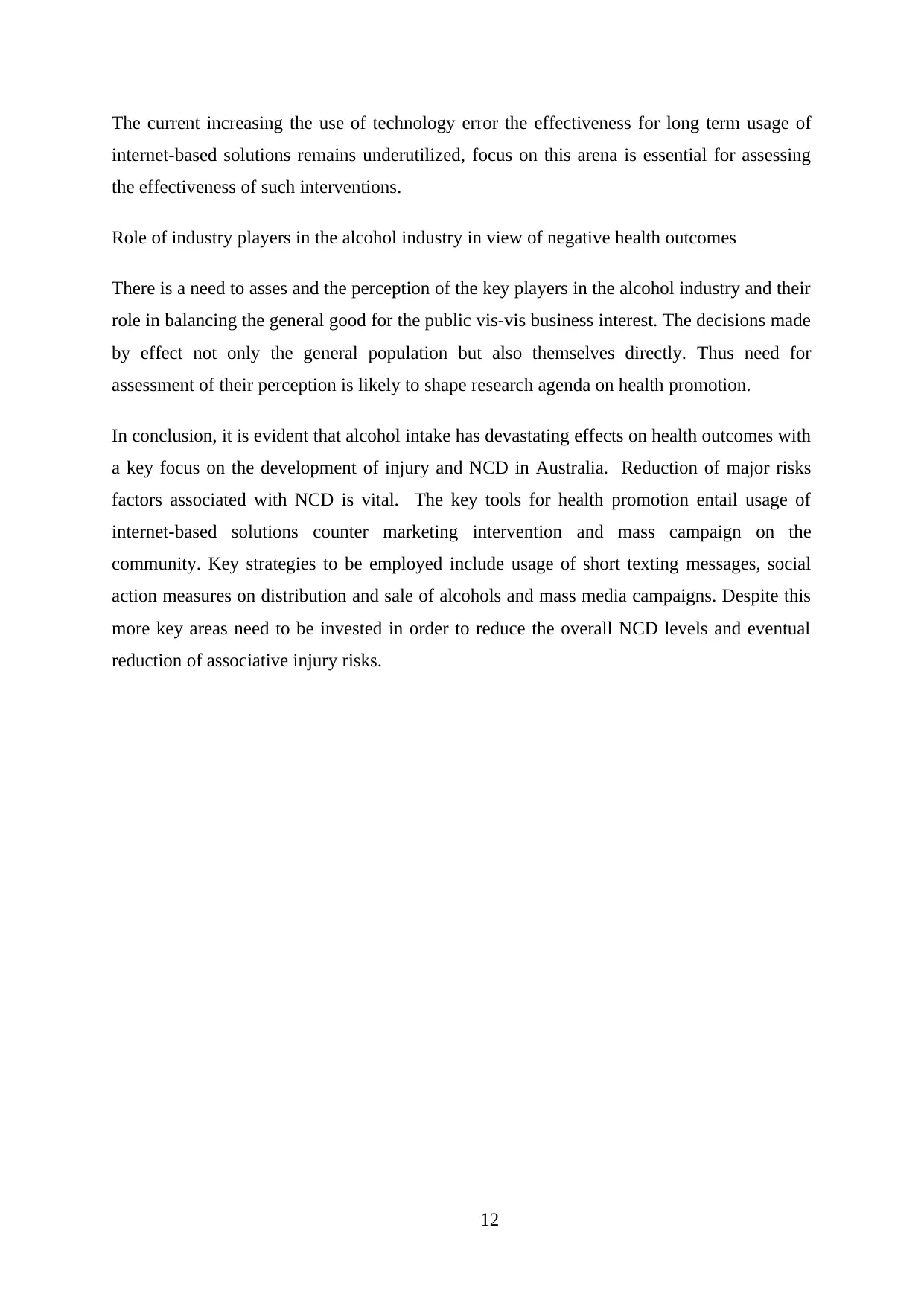
The current increasing the use of technology error the effectiveness for long term usage of
internet-based solutions remains underutilized, focus on this arena is essential for assessing
the effectiveness of such interventions.
Role of industry players in the alcohol industry in view of negative health outcomes
There is a need to asses and the perception of the key players in the alcohol industry and their
role in balancing the general good for the public vis-vis business interest. The decisions made
by effect not only the general population but also themselves directly. Thus need for
assessment of their perception is likely to shape research agenda on health promotion.
In conclusion, it is evident that alcohol intake has devastating effects on health outcomes with
a key focus on the development of injury and NCD in Australia. Reduction of major risks
factors associated with NCD is vital. The key tools for health promotion entail usage of
internet-based solutions counter marketing intervention and mass campaign on the
community. Key strategies to be employed include usage of short texting messages, social
action measures on distribution and sale of alcohols and mass media campaigns. Despite this
more key areas need to be invested in order to reduce the overall NCD levels and eventual
reduction of associative injury risks.
12
internet-based solutions remains underutilized, focus on this arena is essential for assessing
the effectiveness of such interventions.
Role of industry players in the alcohol industry in view of negative health outcomes
There is a need to asses and the perception of the key players in the alcohol industry and their
role in balancing the general good for the public vis-vis business interest. The decisions made
by effect not only the general population but also themselves directly. Thus need for
assessment of their perception is likely to shape research agenda on health promotion.
In conclusion, it is evident that alcohol intake has devastating effects on health outcomes with
a key focus on the development of injury and NCD in Australia. Reduction of major risks
factors associated with NCD is vital. The key tools for health promotion entail usage of
internet-based solutions counter marketing intervention and mass campaign on the
community. Key strategies to be employed include usage of short texting messages, social
action measures on distribution and sale of alcohols and mass media campaigns. Despite this
more key areas need to be invested in order to reduce the overall NCD levels and eventual
reduction of associative injury risks.
12
⊘ This is a preview!⊘
Do you want full access?
Subscribe today to unlock all pages.

Trusted by 1+ million students worldwide
1 out of 16
Related Documents
Your All-in-One AI-Powered Toolkit for Academic Success.
+13062052269
info@desklib.com
Available 24*7 on WhatsApp / Email
![[object Object]](/_next/static/media/star-bottom.7253800d.svg)
Unlock your academic potential
Copyright © 2020–2025 A2Z Services. All Rights Reserved. Developed and managed by ZUCOL.





